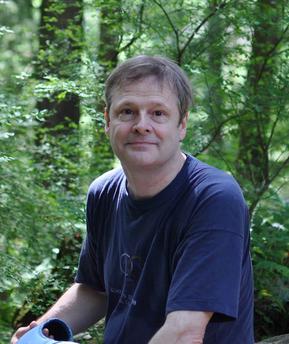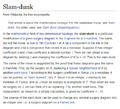Tim Cochran (nonfiction)
Thomas "Tim" Daniel Cochran (April 7, 1955 – December 16, 2014) was a professor of Mathematics at Rice University specializing in topology, especially low-dimensional topology, the theory of knots and links and associated algebra.
Education and career
Tim Cochran was a valedictorian for the Severna Park High School Class of 1973. Later, he was an undergraduate at the Massachusetts Institute of Technology, and received his Ph.D. from the University of California, Berkeley in 1982 (Embedding 4-manifolds in S5). He then returned to MIT as a C.L.E. Moore Postdoctoral Instructor from 1982 to 1984. He was an NSF postdoctoral fellow from 1985 to 1987. Following brief appointments at Berkeley and Northwestern University, he started at Rice University as an associate professor in 1990. He became a full professor at Rice University in 1998. He died unexpectedly, aged 59, on December 16, 2014, while on a year-long sabbatical leave supported by a fellowship from the Simons Foundation.
Research contributions
With his coauthors Kent Orr and Peter Teichner, Cochran defined the solvable filtration of the knot concordance group, whose lower levels encapsulate many classical knot concordance invariants.
Cochran was also responsible for naming the slam-dunk move for Dehn surgery diagrams in low-dimensional topology.
Awards and honors
While at Rice, he was named an Outstanding Faculty Associate (1992–93), and received the Faculty Teaching and Mentoring Award from the Rice Graduate Student Association (2014)
He was named a fellow of the American Mathematical Society in 2014, for contributions to low-dimensional topology, specifically knot and link concordance, and for mentoring numerous junior mathematicians.
Selected publications
- Four-manifolds which embed in R6 but not in R5 and Seifert manifolds for fibered knots, Inventiones Math. 77 (1984), 173–184
- Geometric invariants of link cobordism, Commentarii Math. Helvetii 60 (1985), 291–311.
- Derivatives of links: Massey products and Milnor’s concordance invariants, Memoirs of Amer. Math. Soc. 84 no. 427 (1990)
- Not all links are concordant to boundary links (with Kent Orr), Annals of Mathematics 138 (1993), 519–554.
- Knot Concordance, Whitney Towers and L2-signatures (with Kent Orr and Peter Teichner), Annals of Mathematics 157 (2003), 433–519.
- Structure in the Classical Knot Concordance Group (with Kent Orr and Peter Teichner), Commentarii Mathematica 79, no. 1 (2004), 105–123.
- Noncommutative Knot Theory, Algebraic and Geometric Topology 4 (2004), 347–398.
Knot Concordance and von Neumann rho invariants (with Peter Teichner), Duke Math. Journal, 137, no.2. (2007), 337–379.
- Homology and Derived Series of Groups II: Dwyer's Theorem, (with Shelly Harvey), Geometry and Topology, 12(2008), 199-232.
- Knot concordance and Higher-order Blanchfield duality (with Shelly Harvey and Constance Leidy), Geometry and Topology, 13 (2009), 1419-1482.
- Primary decomposition and the fractal nature of knot concordance (with Shelly Harvey and Constance Leidy), Math. Annalen, 351 no. 2, 2011, 443–508.
- Counterexamples to Kauffman’s conjectures on slice knots (with Christopher Davis), Advances in Mathematics, to appear,
References
- Tim Cochran at the Mathematics Genealogy Project
- "Rice mourns loss of mathematician Tim Cochran". Retrieved December 20, 2014.
- "2 Rice mathematicians honored". Retrieved December 20, 2014.
- "GSA honors those who support grad students at Rice". Retrieved December 19, 2014.
- "List of Fellows of the American Mathematical Society". Retrieved December 18, 2014.
In the News
Fiction cross-reference
Nonfiction cross-reference
- Dehn surgery (nonfiction) - a construction used to modify 3-manifolds. The process takes as input a 3-manifold together with a link. It is often conceptualized as two steps: drilling then filling (also known as Dehn-tistry). It is named after Max Dehn.
- Knot theory (nonfiction) - the study of mathematical knot. A knot is an embedding of a circle in 3-dimensional Euclidean space, R3 (in topology, a circle isn't bound to the classical geometric concept, but to all of its homeomorphisms).
- Robion Kirby (nonfiction) - Robion Cromwell Kirby (born February 25, 1938) is a Professor of Mathematics at the University of California, Berkeley who specializes in low-dimensional topology. Together with Laurent C. Siebenmann he invented the Kirby–Siebenmann invariant for classifying the piecewise linear structures on a topological manifold. He also proved the fundamental result on the Kirby calculus, a method for describing 3-manifolds and smooth 4-manifolds by surgery on framed links.
- Link concordance (nonfiction) - a type of equivalence relationship between two links based on embedding
- Low-dimensional topology (nonfiction) - the branch of topology that studies manifolds, or more generally topological spaces, of four or fewer dimensions. Representative topics are the structure theory of 3-manifolds and 4-manifolds, knot theory, and braid groups. This can be regarded as a part of geometric topology. It may also be used to refer to the study of topological spaces of dimension 1, though this is more typically considered part of continuum theory.
- Mathematician (nonfiction)
- Mathematics (nonfiction)
- Slam-dunk (nonfiction) - in low-dimensional topology, the slam-dunk is a particular modification of a given surgery diagram in the 3-sphere for a 3-manifold. The name, but not the move, is due to Tim Cochran. Let K be a component of the link in the diagram and J be a component that circles K as a meridian. Suppose K has integer coefficient n and J has coefficient a rational number r. Then we can obtain a new diagram by deleting J and changing the coefficient of K to n-1/r.
- Topology (nonfiction) -
External links
- Tim Cochran's home page
- Tim Cochran @ Wikipedia



